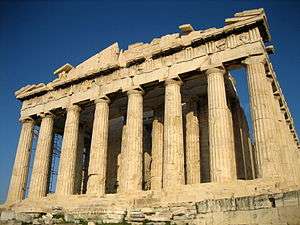Bibliotheca (Pseudo-Apollodorus)
The Bibliotheca (Ancient Greek: Βιβλιοθήκη Bibliothēkē, "Library"), also known as the Bibliotheca of Pseudo-Apollodorus, is a compendium of Greek myths and heroic legends, arranged in three books, generally dated to the first or second century AD.[1]
The author was traditionally thought to be Apollodorus of Athens, but that attribution is now regarded as false, and so "Pseudo-" was added to Apollodorus
The Bibliotheca has been called "the most valuable mythographical work that has come down from ancient times".[2] An epigram recorded by the important intellectual Patriarch Photius I of Constantinople expressed its purpose:
It has the following not ungraceful epigram: 'Draw your knowledge of the past from me and read the ancient tales of learned lore. Look neither at the page of Homer, nor of elegy, nor tragic muse, nor epic strain. Seek not the vaunted verse of the cycle; but look in me and you will find in me all that the world contains'.[3]
The brief and unadorned accounts of myth in the Bibliotheca have led some commentators to suggest that even its complete sections are an epitome of a lost work.
Pseudo-Apollodorus
A certain "Apollodorus" is indicated as author on some surviving manuscripts (Diller 1983). This Apollodorus has been mistakenly identified with Apollodorus of Athens (born c. 180 BC), a student of Aristarchus of Samothrace, mainly as it is known—from references in the minor scholia on Homer—that Apollodorus of Athens did leave a similar comprehensive repertory on mythology, in the form of a verse chronicle. The text which did survive to the present, however, cites a Roman author: Castor the Annalist, a contemporary of Cicero in the 1st century BC. The mistaken attribution was made by scholars from Photius onwards. Since for chronological reasons Apollodorus of Athens could not have written the book, the author of the Bibliotheca is conventionally called the "Pseudo-Apollodorus" by those wishing to be scrupulously correct. Traditional references simply instance "the Library and Epitome".
One of his many sources was the Tragodoumena (Subjects of Tragedies) a 4th-century BC analysis of the myths in Greek tragedies by Asclepiades of Tragilus,[4] the first known Greek mythographic compilation.[5]
Manuscript tradition
The first mention of the work is by Photius in the 9th century. It was almost lost in the 13th century, surviving in one now-incomplete manuscript,[6] which was copied for Cardinal Bessarion in the 15th century; the other surviving manuscripts derive from Bessarion's copy.[7]
Although the Bibliotheca is undivided in the manuscripts, it is conventionally divided into three books. Part of the third book, which breaks off abruptly in the story of Theseus, has been lost. Photius had the full work before him, as he mentions in his "account of books read" that it contained stories of the heroes of the Trojan War and the nostoi, missing in surviving manuscripts. Sir James George Frazer published an epitome of the book by conflating two manuscript summaries of the text,[8] which included the lost part.
Printed editions
The first printed edition of "Apollodorus" was published in Rome in 1555, edited by Benedetto Egio (Benedictus Aegius) of Spoleto, who divided the text in three books,[9] but made many unwarranted emendations in the very corrupt text. Hieronymus Commelinus published an improved text at Heidelberg, 1559. The first text based on comparative manuscripts was that of Christian Gottlob Heyne, Göttingen, 1782–83.[10]
See also
 Ancient Greece portal
Ancient Greece portal
References
Citations
- ↑ Perseus Encyclopedia, "Apollodorus (4)"; Simpson, p. 1.
- ↑ Aubrey Diller, "The Text History of the Bibliotheca of Pseudo-Apollodorus," Transactions and Proceedings of the American Philological Association 66 (1935:296-313), p. 296, 300.
- ↑ Victim of its own suggestions, the epigraph, ironically, does not survive in the manuscripts. For the classic examples of epitomes and encyclopedias substituting in Christian hands for the literature of Classical Antiquity itself, see Isidore of Seville's Etymologiae and Martianus Capella.
- ↑ Smith, R. Scott; Trzaskoma, Stephen M., eds. (2007). "Introduction". Apollodorus' Library and Hyginus' Fabulae: Two Handbooks of Greek Mythology. Indianapolis, Indiana: Hackett Publishing. pp. xxii–xxiii. ISBN 978-0-87220-820-9.
- ↑ Graf, Fritz. Greek Mythology: An Introduction. Baltimore, Maryland: Johns Hopkins University Press. p. 193. ISBN 978-0-8018-5395-1.
- ↑ Bibliothèque nationale, Paris.
- ↑ Bessarion's copy, deposited in the Biblioteca Marciana, Venice, found its way into the Greek manuscripts of Archbishop Laud and came with them to the Bodleian Library in 1636 (Diller 1935:308, 310).
- ↑ Frazer, Apollodorus Loeb Classical Library, 1913.
- ↑ He based his division on attributions in the scholia minora on Homer to Apollodorus, in three books, as Diller noted in 1935 (p. 298 and 308f.
- ↑ Diller 1935.
Works cited
- Diller, Aubrey (1983). Studies in Greek Manuscript Tradition, (Amsterdam: Hakkert ISBN 902560837X) pp. 199–216. Abstract. Originally as "The Text History of the Bibliotheca of Pseudo-Apollodorus", in Transactions of the American Philological Association 66 (1935), pp. 296–313.
- Hard, Robin (1999). The Library of Greek Mythology (Oxford University Press).
- Perseus Encyclopedia, "Apollodorus" (4)
- Simpson, Michael, "Introduction" in Gods & Heroes of the Greeks: The Library of Apollodorus, Michael Simpson (translator), The University of Massachusetts Press, (1976). ISBN 0870232053.
- Smith, R. Scott & Trzaskoma, Stephen M., trans. (2007). Apollodorus' Library and Hyginus' Fabulae: Two Handbooks of Greek Mythology (Indianapolis: Hackett Publishing ISBN 0872208214).
External links
 Greek Wikisource has original text related to this article: (Ψευδο-)Ἀπολλόδωρος
Greek Wikisource has original text related to this article: (Ψευδο-)Ἀπολλόδωρος- Mythographoi. Scriptores poetiace historiae graeci, Antonius Westermann (ed.), Brunsvigae sumptum fecit Georgius Westermann, 1843, pagg. 1-123.
- Apollodori Bibliotheca, Immanuel Bekker (ed.), Lipsiae sumptibus et typis B. G. Teubneri, 1854.
- Mythographi graeci, Richardus Wagner (ed.), vol. 1, Lipsiae in aedibus B. G. Teubneri, 1894: pagg. 1-169 (the epitome in pagg. 171-237).
- Apollodorus, The Library translated by J. G. Frazer
- Apollodori Bibliotheca Electronica: searchable and annotated online bibliography: history of the text, printed editions,textual criticism, etc.
- Apollodorus the Mythographer
- Online text: Apollodorus The Library translated by J. G. Frazer condensed text (4 pp.)